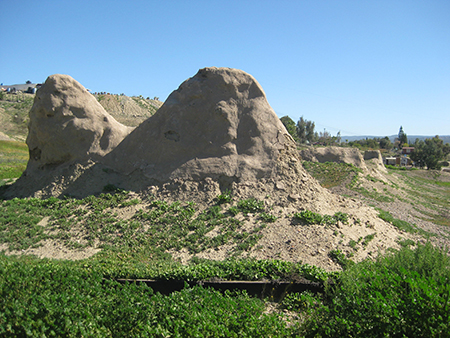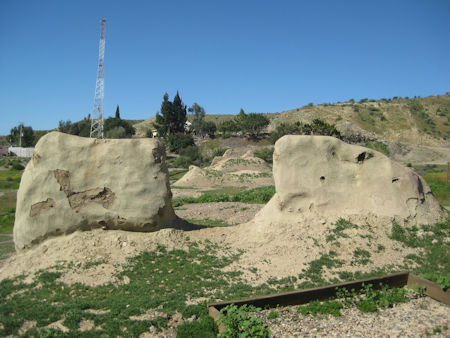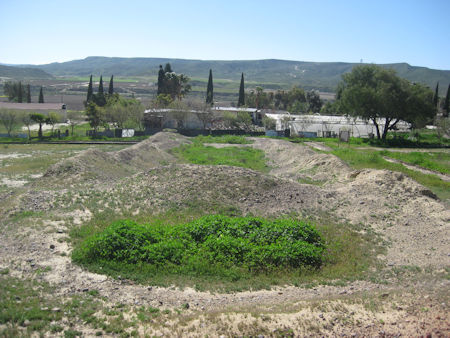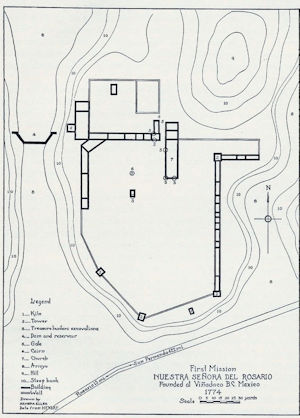 |  |
By David Kier

Spanish missions in California were the first step of Spain’s colonization program. The importance of peaceful coexistence with the Native Californians was foremost on the agenda. The missionaries were charged with educating the Native people to speak the King’s language and be incorporated into the Catholic church. The Jesuits were the first Order of the church to convert California. The Franciscans followed after the Jesuits were removed during the expulsion of 1767-1768. The second year of the Franciscan operations, they were given the task to occupy the ports of San Diego and Monterey. This new region became known Alta (Upper) California. The peninsula would be identified now as Baja (Lower) California.
Following their expedition into Alta California, the Franciscans were willing to share mission duties with the Dominican Order of Preachers, who had previously sought to operate some of the California missions. In 1773, the Dominicans arrived at Loreto and they were given control of the entire peninsula, so the Franciscans could focus on the new territory to the north. The Dominicans were also tasked with establishing five new missions in the land south of San Diego to San Fernando de Velicatá (the first California Franciscan mission founded by Junípero Serra, in 1769).

In December of 1773, while exploring out from the northernmost Baja California mission of San Fernando de Velicatá, Dominican President Vicente Mora investigated a valley inhabited by Cochimí Indians called Viñadaco. Mora was accompanied by two other Dominican missionaries, Miguel Hidalgo and Francisco Galistéo. The valley was investigated, detailed, and water sources identified. Many freshwater ponds were present, and Mora wanted to know if they were river fed or spring fed. Wells were dug, and water gushed out with much force at one. In that direction, another well was dug on an elevated terrace and again, water flowed with great force. This report was prepared for the governor:
In the said place one can plant seed (and raise produce) with only the humidity, without the need of drawing water for years. Water is here in such abundance that the site has a lagoon to the south, whose bottom cannot be seen, and its length is more than one thousand varas. At the end of the lagoon there is a flow of water which is a buey and a half wide. At the foot of an elevated hillock there is a marsh, and near its place of origin, between the craggy brambled ground of the mount, one can see an abundance of water, which probably is about two bueyes wide. At the head of the said marsh, on the highest place at the foot of the hillock, the Reverend Father President, Vicente de Mora, in company with the Reverend Fathers Hidalgo and Galistéo, gave orders to make a hole two and a half varas deep. In a very beautiful, tiny spot of the good earth, there was found a powerful water spring, without any bad taste. This water spring is away from the arroyo, which in the foresaid vicinity has several holes of water. I say this, not because it is exceptional, but because it is distinguished by innumerable water plants and most abundant bull rushes, vatamotalez, and reeds.
Note: a vara is about 33 inches, and a buey means “the size of an ox”
Before official permission was received, Mora wanted the new mission opened as the Indians were coming forth to be baptized in great numbers. Padre Galistéo would be in charge of the new mission. It was founded on July 24, 1774 as Nuestra Señora del Rosario Viñadaco. The location is 5 miles from the ocean and today is in the town of El Rosario, just a long block uphill of Highway One, 0.8 mile past the Baja Cactus Motel and gas station.

Galistéo was born about 1735 in Carcabuey, Spain. Assigned originally to Mission La Purísima in 1773 but was soon transferred to Mission San Fernando to assist in the expansion of the Dominican missions. The new El Rosario mission compound had defensive walls and towers in case of attack from unfriendly tribes. The mission church was built from the north side and faced south, 132 feet long by 27 feet wide.
Industrial shops were along the west side, above the creek. A dam was built to hold the water which flowed from the well dug the year before. The shops included a forge, a carpenter’s room, a masonry shop, a warehouse, weaving and spinning rooms. Living quarters for the Indians ran along the east side of the quadrangle, near the missionaries’ quarters. The soldiers likely lived on the other side of the church along the north side of the quadrangle.
The two main products from the mission lands were grain (corn, wheat, barley) and cattle. Vegetables, figs and grapes were also grown. One sea captain wrote in 1825, that he anchored in Rosario Bay (by Punta Baja) and purchased cattle, deer, sheep, hogs, potatoes, and vegetables, at moderate prices. The mission was also catching sea otters and selling the skins.
In 1802, the water source failed, and it was decided to move the mission 2 miles down the valley and closer to the river, at a location previously named San José. The new location became known as Rosario de Abajo (Lower Rosario). The compound was smaller and not so enclosed as was the first site. To reach it, follow the signs after turning right where the highway makes a sharp left turn, just past Mama Espinoza’s Restaurant. The road is soon unpaved and crosses the river then continues west on the south side of the river. The second mission site is in the town of El Rosario de Abajo, 2.0 miles from the highway.

The last resident missionary was Francisco Troncoso (1819-1822) who left his post when many other Spanish born padres left, as Mexico and the Californias had achieved their independence from Spain. Some Dominicans remained in service of the Indians, who had never achieved equality with other Spanish citizens in the Californias. Antonio Menéndez of San Vicente and Tomás Mansilla of Santo Tomás visited El Rosario from their missions to perform priestly duties after 1822. 1831 and 1844 were the final two years that had baptism and marriage entries into the mission’s record books.
About David
David Kier is a veteran Baja traveler, author of 'Baja California - Land Of Missions' and co-author of 'The Old Missions of Baja and Alta California 1697-1834'. Visit the Old Missions website.

SIMPLE, STRAIGHTFORWARD. OLD GUYS LIKE THAT. WILL DEFINITELY USE IN 6 MONTHS IF STILL RUNNING...

Recommended by others who have visited Mexico from the US. They were easy to use, clear in...

One of the best Insurance experiences I've had. One, the prices are very very fair, especially...